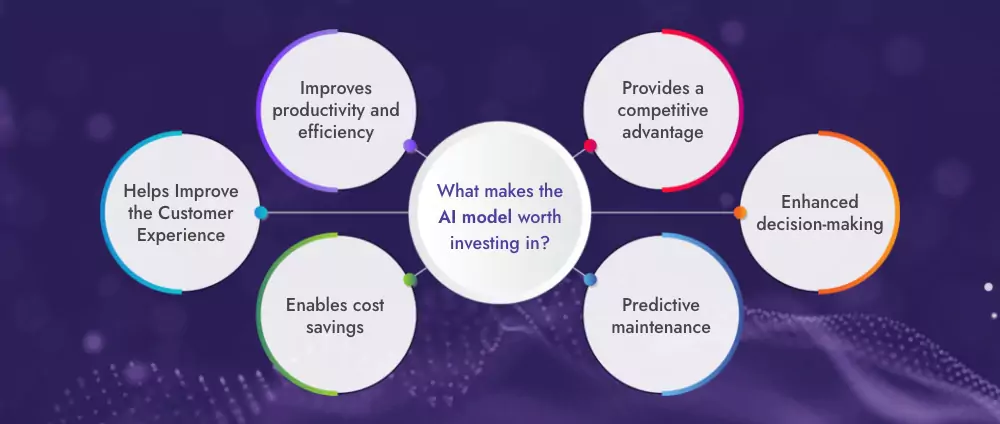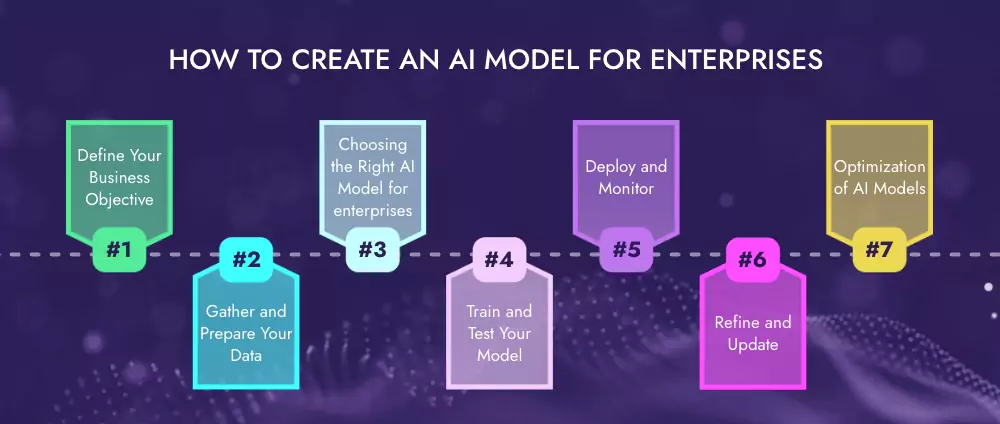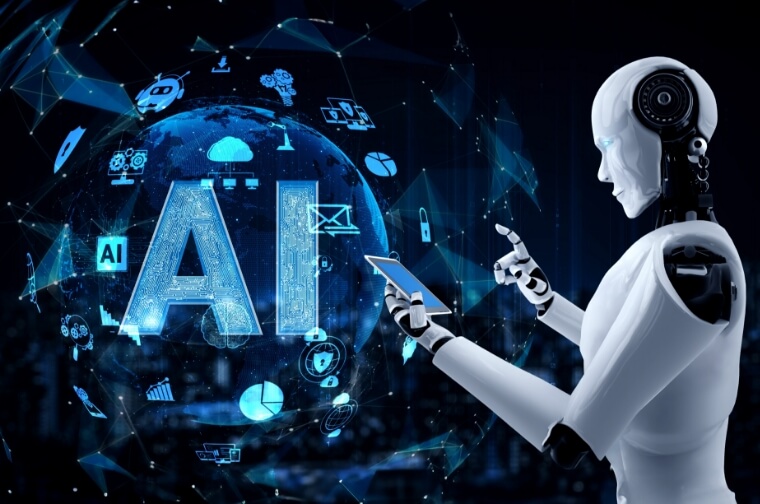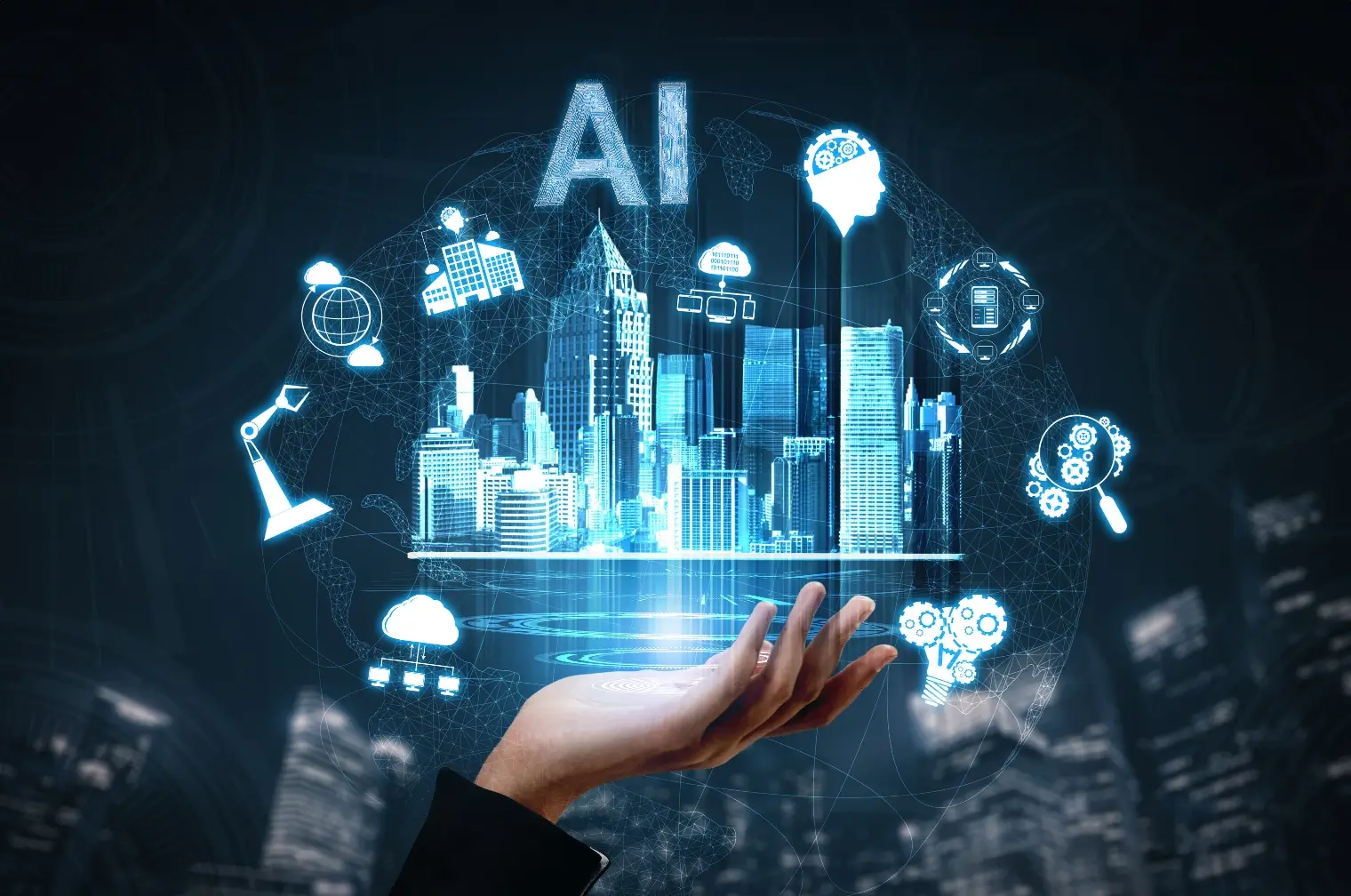Machine Learning and AI for revolution of Tech Companies are changing and streamlining businesses.
The dream of machines with human-like intelligence (AI) has long-fired imaginations. Today, the digital revolution makes it a reality. Data is the fuel, algorithms, and tools. Businesses must embrace AI to thrive.
Build custom AI models to solve customer problems, optimize operations, and personalize experiences. But how can you profit from this opportunity for your business?
Intelligent AI models hold the key to solving specific business problems. These are savvy systems that have been educated on your particular data. An AI model is an excellent tool for simplifying complex processes and augmenting human capabilities by achieving new levels of efficiency and accuracy.
This guide will give you the knowledge on how to create an AI model and propel your business into a brighter future.
What is an intelligent AI model for enterprises?
An intelligent AI model is a computer program that mimics human cognitive functions like learning and problem-solving. It achieves this by analyzing vast amounts of data, identifying patterns, and making predictions. These models can be applied across diverse areas, from optimizing logistics to automating customer service interactions. A recent McKinsey report for productivity and growth estimates that AI could contribute up to $15.7 trillion to the global economy by 2030.
An intelligent AI application or model is distinguished by its capacity to learn, reason, comprehend, adapt, interact, solve problems, and produce reliable results. One of the examples of intelligent AI models is ChatGPT, a language model that can write human-like prose in response to commands and recognize objects, people, and scenarios in photographs.
What makes the AI model worth investing in?
Investing in intelligent AI models is a strategic move for your enterprise. Custom AI model development can have a transformative impact on various aspects of your business operations.
Here are several compelling reasons why it’s worth your investment.

Helps improve the customer experience
AI-powered solutions, like virtual assistants, personalized recommendations, and chatbot development services, enhance customer interactions.
They contribute to an improved overall user experience.
Improves productivity and efficiency
AI software is intended to streamline processes, automate rule-based tasks, and maximize resources. By automating monotonous jobs with AI, you can focus on more strategic activities in your business.
Enables cost savings
Advanced AI models and technology reduced operational expenses dramatically by simplifying labor-intensive operations and allocating resources more efficiently.
Over time, the successful application of AI models for enterprises has resulted in various financial benefits for large-scale enterprises.
Provides a competitive advantage
Building an AI model gives businesses a competitive advantage by allowing them to innovate at the leading edge.
AI software and technology can enable new product creation and business models, expanding the potential for long-term business success.
Enhanced decision-making
AI models for enterprises analyze vast datasets, uncovering hidden insights that inform better business decisions.
Predictive maintenance
Anticipate equipment failures and prevent costly downtime with AI-powered predictive maintenance.
The global AI market is expected to grow from $62.35 billion in 2020 to $733.7 billion by 2027.
How to create an AI model for enterprises
We’ve shown the power of custom AI model development to transform your business. Now, let’s break down the development process in depth, putting theoretical power into real steps:

#1 Define Your Business Objective
To truly advance our AI project, you must delve into the core of our operations rather than settling for aspirations of “improved efficiency.” Let’s focus on pinpointing:
- Finding what’s slowing us down: Take a close look at where you’re hitting roadblocks. Is it taking forever to process loan applications? Or are you losing too many customers? Once you figure that out, you can start fixing it.
- Automating the boring stuff: You probably have dull and repetitive tasks. Let technology handle those for you. Things like typing in data or setting up appointments can be automated, giving you more time for the important stuff.
- Using AI to make better decisions: AI can help us make better decisions. It could warn you when equipment might break or help you run your marketing in a way that grabs more attention.
The more precise your objective, the more targeted and effective your intelligent AI model development will be.
#2 Gather and prepare your data
Think of your data as the source for your AI. The quality and quantity of data directly impact the performance of your model. Here’s what you need to consider:
- Relevance: Does your data directly address the problem you’re trying to solve? Irrelevant data can skew your results.
- Accuracy: Your data needs to be spot-on. Mistakes in your data can mess up your AI, so keep it clean.
- Sufficiency: You don’t want too little or too much data. Too little, and your AI won’t learn properly. Too much, and it could take more time to learn.
Data Cleaning and Preprocessing: This often involves identifying and removing outliers, formatting data consistently, and handling missing values.
#3 Choosing the right AI model for enterprises
AI models are vast, with different models excelling at specific tasks. Here’s a simplified breakdown of some common choices:
- Classification: It organizes things into categories, like how a spam filter sorts emails into “spam” or “not spam.”
- Regression: Guesses numbers. Think of it like predicting how much you’ll sell next month based on past sales.
- Clustering: Finds groups. It’s like sorting your customers into different groups based on things they have in common.
- Natural language processing (NLP): Understands language. For example, chatbots that can chat with customers and understand what they’re saying.
Understanding these categories and researching available models will help you select the one best suited to your objective.
#4 Train and test your model
This is where the magic happens! You’ll use your chosen AI model and prepare data for training purposes. Here’s a simplified overview:
- Training: The model analyzes your data, learning patterns, and relationships. Imagine studying for an exam.
- Testing: Like a school exam, you test the model’s performance on unseen data. Does it accurately predict outcomes or categorize data points?
- Iteration: This usually isn’t a one-time thing. Depending on how the testing goes, you might need to tweak your model, like changing its settings, or even try a different one altogether.
#5 Deploy and monitor
Once your AI model is trained and tested, it’s time to integrate it into your existing workflows. This might involve:
- Developing an application: This allows your model to interact with your existing systems and users.
- Setting up monitoring tools: Track the model’s performance in real-world scenarios. Is it delivering the expected results?
#6 Refine and update
AI models are not static creatures. As your business evolves and new data becomes available, you must retrain and update your model to maintain optimal performance. Think of it as keeping your AI running smoothly.
#7 Optimization of AI models
Dropout, regularization, and batch normalization are optimization approaches that can improve the AI model’s performance. Furthermore, fine-tuning individual hyperparameters like learning rate, batch size, or network depth might help achieve better outcomes.
Transform your enterprise with our expert AI model development services.
Considerations while creating AI models for enterprises
As companies decide to construct an AI model, it is critical to consider various factors to ensure its success. We’ve identified a few factors that influence the custom AI model-building process:
Structure and sacrifice ability of AI models
Enterprise AI models require a significant amount of computer resources. Investing in scalable infrastructure while developing AI models is critical to correctly managing the training and deployment processes. Cloud-based solutions such as Azure, AWS, and Google Cloud are known for their scalability and flexibility.
Data security and privacy
Sensitive information is typically found in company data. When developing an AI model, it is critical to integrate robust privacy and security safeguards to secure sensitive data.
Generative AI
As AI technology advances, generative AI development services have emerged as a critical trend.
ChatGPT is an example of a generative AI model capable of producing text, pictures, and code. This movement creates new potential for innovative problem-solving, automation, and the creation of distinctive content within enterprises.
Regulatory compliance
Regulations vary by industry. While developing an AI model, you must ensure it complies with applicable industry standards and data protection legislation such as HIPAA and GDPR.
Ethical considerations
Be mindful of potential biases in your data and design your model for fair and ethical outcomes.
Build intelligent AI model development solutions with ViitorCloud
To create an AI model, organizations must first identify their goals and what they want to provide their customers. A proper roadmap must be established to ensure that the custom AI model development for enterprise processes is fluid and practical.
ViitorCloud’s expertise in designing an AI model highlights the need to create a data-driven culture, define business objectives, and use the appropriate AI technology.
Our professional experts can provide innovative solutions for developing various AI models that will assist your company in growing, innovating, and becoming more efficient. Collaborate with us to experience AI’s transformative capacity to increase productivity, promote economic growth, and remain ahead of the curve.
At ViitorCloud, we offer comprehensive AI development services to guide you through every stage of the AI model creation process. Our team of experts will help you design, develop, and deploy a custom AI model tailored to your specific needs.
Ready to unlock your enterprise AI solutions? Contact us today to discuss your project!
Frequently asked questions
The impact of AI on organizations is broad and significant:
- Enhanced customer experience: Personalized AI-enabled interactions increase customers’ experiences through personalized recommendations and adequate customer support.
- Increased productivity: AI automates repetitive tasks, streamlining operations and freeing up human resources for critical initiatives.
An intelligent AI model for businesses examines multiple data sets with modern algorithms and machine learning. It learns from previous data trends, correlations, and insights as it trains. Following training, it integrates into business operations, automating procedures, anticipating outcomes, and generating data-driven recommendations.
AI models recognize patterns using natural language processing, computer vision, and machine learning. Intelligent AI models also employ decision-making algorithms to learn from their training, collect and assess data points, and then apply their knowledge to achieve their objectives.
AI models have a wide range of applications across industries. Here are a few examples: Manufacturing, Retail, Finance, Healthcare, and Customer service. Enterprise AI solutions can gain a significant competitive advantage and unlock new possibilities for growth and innovation.









